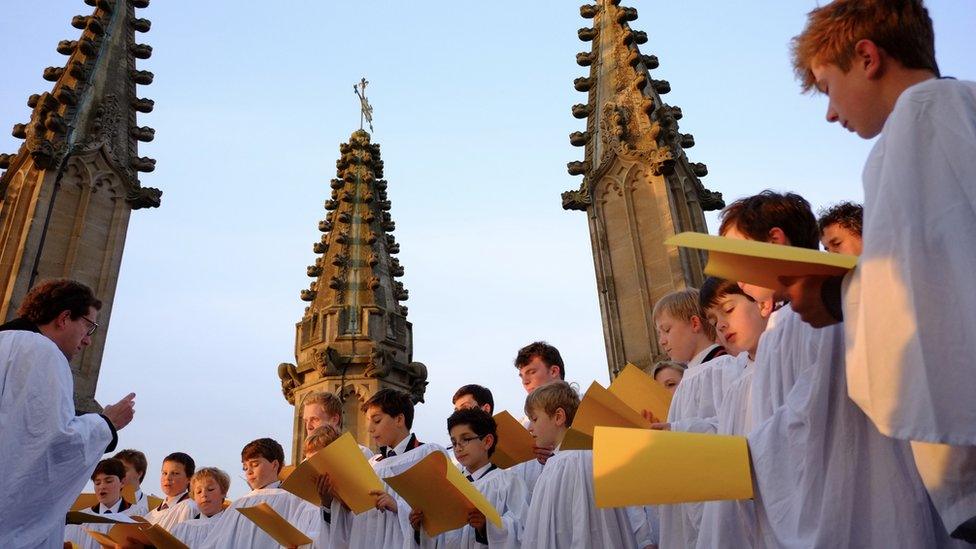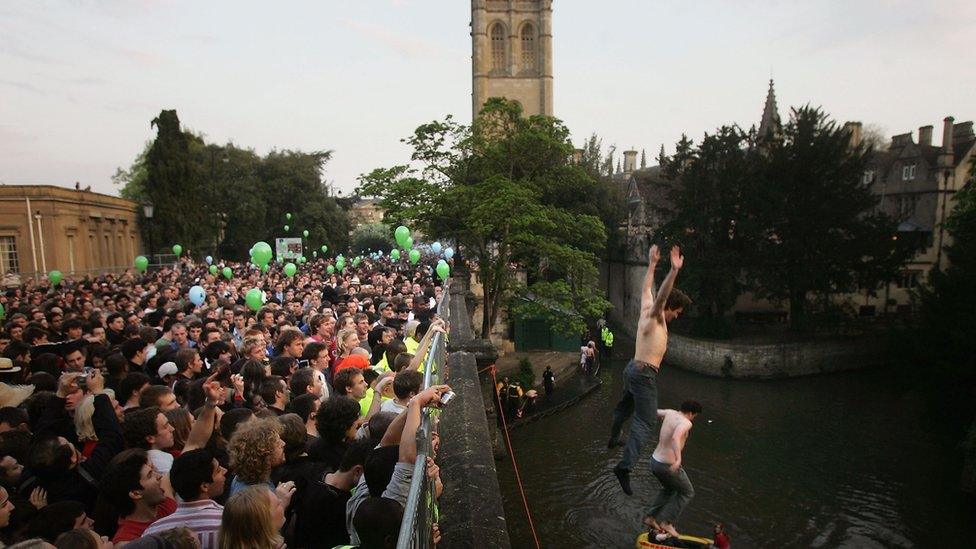May Morning: Oxford's 500-year-old tradition
- Published
What is Oxford's May Morning?
On most early mornings the streets of Oxford are empty, save for the odd second-year student dragging his or her intoxicated heels back to their halls of residence.
But on 1 May tens of thousands of people congregate outside Magdalen College for 06:00 BST.
The reason for this bulging throng is the 500-year-old tradition of May Morning, when the university city unites to take part in celebration of spring - with an Oxford twist.
So what is it about the quirky three-hour early morning festival which last year saw 25,000 people get up at the crack of dawn?
Magdalen College Choir prepare for May Morning
As the bells of Magdalen College Tower ring on the hour, the crowds fall silent, and from the top of the tower the college's choir serenade the city with a hymn.
"It's really quite magical," city events officer Rachel Capell says.
"We are talking about thousands of people in a very small space, very close-knit together, but with the ability to hear a pin drop right before the choir sings."

On May Morning, the choir - which includes boy choristers from the college's affiliated school - ascend the 144ft bell tower up the narrow, precarious steps in the medieval building.
Informator choristarum Mark Williams said: "It is quite a steep climb and the last bit is just a ladder, so anyone who's slightly nervous of heights won't enjoy it.
"But I think once you're up there it's quite an experience."

The choir has to begin climbing the tower 30 minutes before they begin singing at 06:00 BST
The choir then performs Hymnus Eucharisticus, written by the college's 17th Century choirmaster Benjamin Rogers, then three madrigals before the tower bell ringers begin a celebratory chime.
As the bells swing on the rig, the tower sways up to 4in (10cm) at the top.
Home bursar Mark Blandford-Baker said: "It feels like about 4ft when you experience it the first time."
But he's confident: "Of course, our medieval forebears knew what they were doing. We're here 500 years on, it's not going to fall down this May Morning."
The origins of May Morning are sketchy, but many believe it dates to the time the tower was built and the college chose to sing in spring.
It has remained uniform since the 17th Century, when the carol Hymnus Eucharisticus was written by the Benjamin Rogers at the college, thus ensuring its enduring appeal.

The Morris Men are out in force in the centre of town
Although a family-friendly event, students will often take full advantage of late closing times at pubs across the city and perform an all-night drinking endurance test.
At 05:00 cafes and pubs will reopen to offer the bleary-eyed undergraduates a chance to sober up before the choir sings.
In previous years students would famously undress and jump into the shallow River Cherwell from Magdalen Bridge, but this was stopped in 2005 when 40 revellers required treatment after jumping into 2ft (60cm) deep water.
However, there are other attractions once spring has been sung in and the bells have been rung.
It's then the crowds move through the city as Morris men parade through the streets towards Radcliffe Square to begin three hours of dancing and folk music.
The Oxford University Morris Men begin the festivities by performing Bonny Green around High Street, and sides continue dancing and performing across the city until about midday.
Oxford City Morris Men squire Graham Diggle says 150 performers take part.
It's their annual highlight, he says, it's when the community celebrates.

Students used to engage in an act of anarchic clothes-lessness and jump from Magdalen Bridge into the shallow River Cherwell